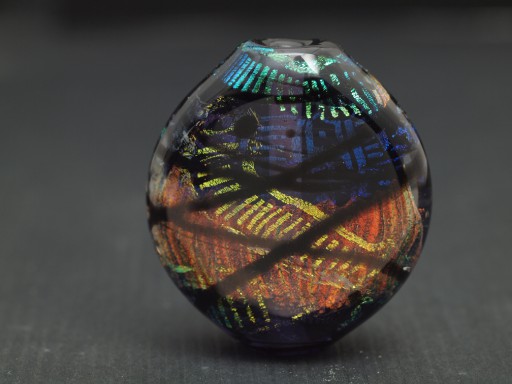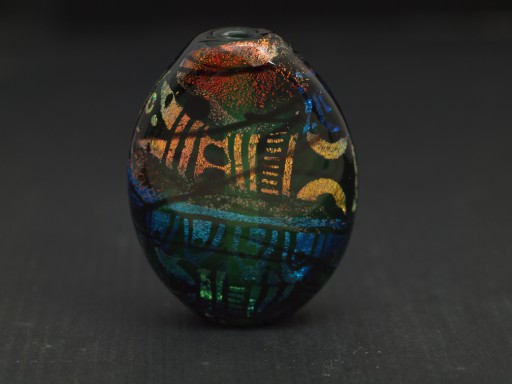Lisa St Martin is a lampworker specializing in large, glitzy soda-lime beads. She is all about the sparkle: leaf, mica, silver bearing glass and especially dichro: if it's glitters, she's probably tried it:)
Lisa started out as a furnace worker, and this heritage reflects itself in the size of her work—her famous ‘snowflakes’ can get up six inches across. She's been working glass roughly 30 years, and was for some time the SGB/ISGB's ‘Mistress of Fire’ —the person responsible for convincing the fire marshalls to let us set and use torches at the conference, and also, actually, setting them up along their assorted paraphernalia —tanks, sheetrock table coverings, and the like. This job involves a lot of crawling around under tables with wrenches, and is a royal PITA. I was volunteered offered to perform this task (on a much smaller scale, of course) for Lisa's class.[1]
Lisa and I go back at least to the 2002 (Alexandria) Gathering, and I love her beads, so I was happy to do some photography for her.

Untouched photo, E620, 50mm zuiko macro prime, photoflood lighting. f5, 1/30sec. Click on any image to see it full size.
First up, a fairly standard photo, shot on my favourite light grey flecked paper, using a light cube, with a photoflood at 45 degrees from the left, and angled up about 45 to the ceiling as well. (All images were shot with an Olympus E-620 body, a zuiko 50mm macro prime lens with the subject inside a white diffusing photocube.) I like this picture, but it highlights the transparency of the bead rather than the dichro, and the client wanted to emphasize the dichro, since the images were to be submitted for a show/exhibit/article that emphasized dichro. If the background permits (which sometimes it doesn't) I put a fair amount of negative space around the bead to permit more flexibility in cropping.[2]

Same as above, but this time using a dark background and flash. It's a fully manual flash, and so the camera doesn't record the power level. Yes, the dust on the background is appalling, but it is stuck on there but good.[3]
I liked the first photo, but the setup is optimized to show off beads in which the reflected and transmitted light are roughly balanced. Although dichroic glass, as the name implies, is manufactured to both transmit and reflect light in beautiful ways, ironically enough, I needed to increase the emphasis on the surface, i.e. reflected, rather than transmitted, light.[4] One way to do this was to change the background to something that would absorb more of the ambient light.
However, the images shot with the photoflood were showing a disturbing lack of focus in the dichro particles. Maybe the tripod, which is getting old, simply wasn't locked down hard enough, but at very slow speeds—say 1/10sec or slower, I've noticed that highlights tend to blow out and look blurry, even if the rest of the image is razor sharp and my clipping indicators are good.[5] At any rate, I was exhausted and after discussing the problem with Lisa, decided to go to bed and try again the following day.
After some sleep, I realized I was gonna have to go with flash. I also thought that perhaps I ought to try a gobo: I thought this might help bring out the dichro. It did seem to help, but the images look far better on the monitor that I color-balanced; on the other one, which experience has dictated is closer the average consumer experience, these pictures look rather dark.
And what is a gobo? Well, typically I soften light using a light cube,[6] or sheets of translucent white plastic (or, commonly, both.) A gobo is a black something or other (more plastic in my case) that blocks light completely. That's why those iconic movie lights have those little flaps around the lamp, so that the lighting person can adjust where the light falls. My system, which involves waving around various sized pieces of mirrored, translucent white or black cards/boards, is a more primitive version of the same idea.
I haven't used gobos to much effect before, so it was fun to play with them.
[1]Anybody with sense, or who has to swap torches around for very long, soon discovers the joy of quick-disconnects. Yes, they're expensive. But worth every penny. And no, this venue did not have them, why do you ask?
[2]Back in the old days of transparencies, when your crop tool was silver tape and an exacto blade, things had to be composed a lot more carefully and tightly. No, I absolutely don't miss film.
[3]Frankly, it's probably some kind of mold. In a perfect world I would put the subjects on tilted black plexi, but the thought of tipping a bunch of large expensive beads onto my basement floor was just not one I was willing to entertain, especially not with the time constraints I was working under.
[4]Having to cope with both factors is what makes shooting glass so interesting:)
[5]I think it's just a limitation of the sensor, but my understanding of camera physics/mechanics is pretty, ahem, fuzzy.
[6] which is just a box covered in translucent white fabric
Unless otherwise noted, text, image and objects depicted therein copyright 1996--present sylvus tarn.
Sylvus Tarn